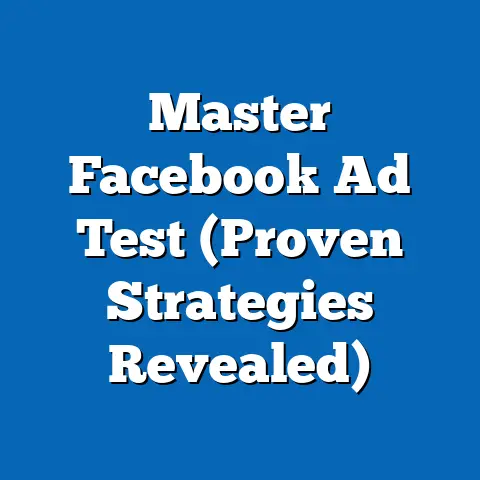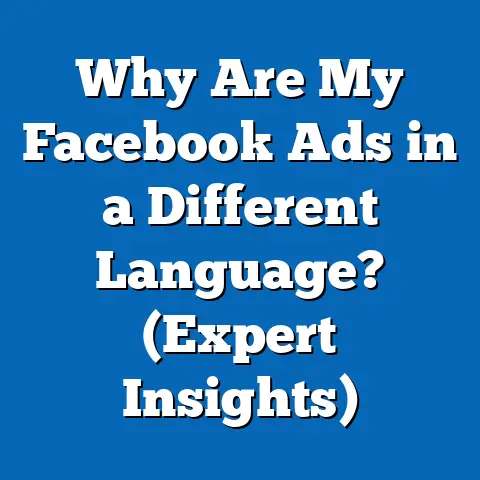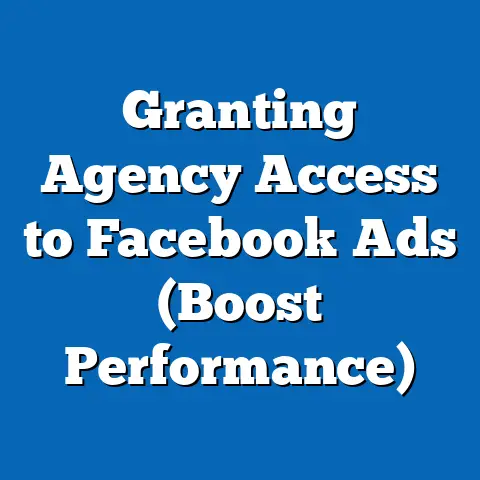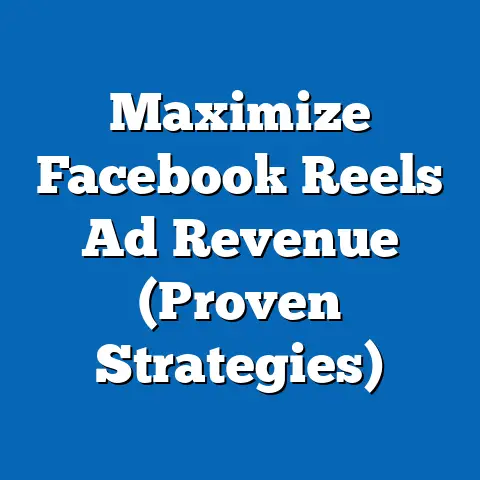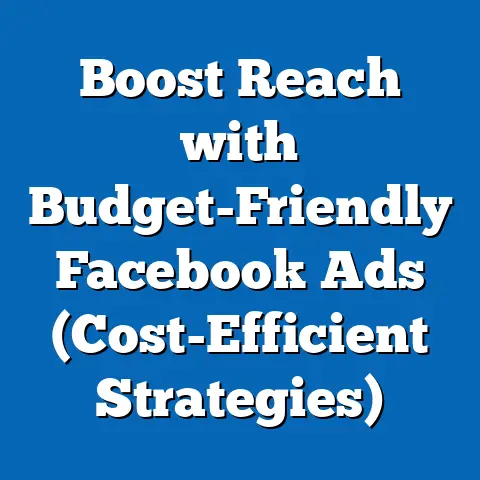Maximize ROI with Facebook Ads Pay Per Conversion (Pro Tips)
The digital landscape is constantly evolving, and with it, the world of online advertising. Social media platforms like Facebook have become powerhouses for businesses looking to connect with their target audience and drive conversions. But with so many ads vying for attention, how do you ensure your campaigns stand out and deliver a strong return on investment (ROI)? Enter Pay Per Conversion (PPC), a game-changer for businesses that want to maximize their advertising dollars. It’s not just about getting clicks; it’s about turning those clicks into paying customers.
I remember the first time I truly understood the power of a well-optimized PPC campaign. I was working with a small e-commerce business struggling to get traction. They were running Facebook ads, but their ROI was abysmal. They were paying for clicks, but very few of those clicks were translating into sales. We decided to switch to a Pay Per Conversion model and really focus on understanding their customer’s intent. We revamped their ad copy, improved their landing page experience, and narrowed down their targeting. The results were astounding! Their conversion rate skyrocketed, their cost per conversion plummeted, and their overall ROI saw a dramatic increase. That experience solidified my belief in the power of PPC and the importance of understanding customer intent.
In today’s competitive market, mastering Pay Per Conversion is no longer optional; it’s essential. It’s about understanding your customers – what they want, what they need, and what motivates them to buy. By focusing on customer intent and behavior, you can craft PPC campaigns that resonate with your audience, drive higher conversion rates, reduce costs, and ultimately, create a more profitable advertising strategy.
Here’s what you can expect to learn in this guide:
- Understanding Facebook Ads and Pay Per Conversion: I’ll break down the mechanics of Facebook Ads and explain why the Pay Per Conversion model is a smart choice for businesses.
- Setting Clear Goals and KPIs: I’ll show you how to define your objectives and establish measurable metrics to track your progress.
- Crafting Compelling Ad Copy and Creative: I’ll share the secrets to creating ads that capture attention and drive conversions.
- Advanced Targeting Strategies: I’ll reveal how to leverage Facebook’s targeting tools to reach the right audience with the right message.
- Monitoring and Optimizing Campaigns: I’ll provide pro tips on how to analyze your data and make data-driven decisions to improve your ROI.
- Scaling Successful Campaigns: I’ll guide you on how to expand your reach and increase your profits without sacrificing performance.
Section 1: Understanding Facebook Ads and Pay Per Conversion
Facebook Ads have become a cornerstone of digital marketing, offering businesses unparalleled reach and targeting capabilities. With billions of active users, Facebook provides a massive audience for your message. But navigating the complexities of Facebook advertising can be daunting. Let’s break down the basics and explore the benefits of the Pay Per Conversion model.
Overview of Facebook Ads: Types, Targeting, and Segmentation
Facebook Ads offer a diverse range of ad formats to suit different marketing objectives. Here are some of the most popular:
- Image Ads: These are simple and effective ads that feature a single image and accompanying text. They’re great for showcasing products or services and driving traffic to your website.
- Video Ads: Video ads are more engaging than image ads and can be used to tell a story, demonstrate a product, or build brand awareness.
- Carousel Ads: Carousel ads allow you to display multiple images or videos within a single ad unit, each with its own headline, description, and link. This format is ideal for showcasing a range of products or highlighting different features of a single product.
- Collection Ads: Collection ads are designed for e-commerce businesses and feature a visually appealing catalog of products. They’re a great way to drive sales directly from Facebook.
- Lead Ads: Lead ads make it easy for people to sign up for newsletters, request quotes, or download resources without leaving Facebook. They’re perfect for lead generation campaigns.
- Instant Experience Ads: Instant Experience Ads are full-screen, mobile-optimized ads that load instantly when someone clicks on them. They offer a highly immersive and engaging experience for users.
One of the most powerful features of Facebook Ads is its advanced targeting capabilities. You can target your ads based on a wide range of factors, including:
- Demographics: Age, gender, location, education, and other demographic information.
- Interests: Hobbies, interests, and pages that people have liked on Facebook.
- Behaviors: Past purchase behavior, online activity, and other behavioral data.
- Connections: People who are connected to your Facebook page or app.
- Custom Audiences: You can upload your own customer data (e.g., email addresses, phone numbers) to create custom audiences and target your ads to existing customers or lookalike audiences.
- Lookalike Audiences: Facebook can create lookalike audiences based on your existing customer data, targeting people who share similar characteristics and behaviors with your best customers.
Effective audience segmentation is crucial for maximizing the ROI of your Facebook Ads. By dividing your target audience into smaller, more specific segments, you can tailor your ad copy and creative to resonate with each group. This leads to higher engagement rates and more conversions.
I’ve seen firsthand how powerful audience segmentation can be. I worked with a clothing retailer that was running generic ads to a broad audience. Their results were mediocre at best. We decided to segment their audience based on age, gender, and interests. We created separate ad campaigns for each segment, with ad copy and creative that were specifically tailored to each group. The results were remarkable! Their conversion rate increased by over 50%, and their cost per conversion decreased significantly.
Explanation of the Pay Per Conversion Model
The Pay Per Conversion (PPC) model is a type of online advertising where you only pay when someone takes a specific action, such as making a purchase, filling out a form, or signing up for a newsletter. This is different from traditional Pay Per Click (PPC) advertising, where you pay each time someone clicks on your ad, regardless of whether they convert into a customer.
With Pay Per Conversion, you set a target cost per conversion (CPC) and Facebook will optimize your ads to achieve that goal. Facebook uses its sophisticated algorithms to identify the users who are most likely to convert and show your ads to them.
Here’s how it works:
- Define Your Conversion Goal: Determine what action you want people to take after clicking on your ad (e.g., purchase, lead submission, signup).
- Set Your Target Cost Per Conversion: Decide how much you’re willing to pay for each conversion.
- Create Your Ad Campaign: Design your ad copy and creative, and set your targeting parameters.
- Facebook Optimizes Your Ads: Facebook’s algorithms will automatically optimize your ads to achieve your target cost per conversion.
- You Only Pay for Conversions: You’ll only be charged when someone takes the desired action after clicking on your ad.
The Pay Per Conversion model offers several advantages for businesses:
- Higher ROI: You only pay when you get a desired result, which can lead to a higher ROI compared to traditional PPC advertising.
- Reduced Risk: You’re not paying for clicks that don’t lead to conversions, which reduces your risk.
- Improved Efficiency: Facebook’s algorithms automatically optimize your ads, saving you time and effort.
- Better Targeting: Facebook’s advanced targeting capabilities ensure that your ads are shown to the people who are most likely to convert.
Comparison of Pay Per Conversion vs. Traditional PPC Models
| Feature | Pay Per Conversion (PPC) | Traditional Pay Per Click (PPC) |
|---|---|---|
| Payment Trigger | Conversion | Click |
| Risk | Lower | Higher |
| ROI Potential | Higher | Lower |
| Optimization | Automated | Manual |
| Targeting | Data-Driven | Keyword-Driven |
| Feature | Pay Per Conversion (PPC) | Traditional Pay Per Click (PPC) |
|---|---|---|
| Payment Trigger | Conversion | Click |
| Risk | Lower | Higher |
| ROI Potential | Higher | Lower |
| Optimization | Automated | Manual |
| Targeting | Data-Driven | Keyword-Driven |
As you can see, the Pay Per Conversion model offers several advantages over traditional PPC advertising. It’s a more efficient and cost-effective way to reach your target audience and drive conversions. While traditional PPC can be useful for driving traffic, PPC focuses on acquiring customers and getting real results.
Takeaway: Understanding the different types of Facebook Ads and the benefits of the Pay Per Conversion model is the first step towards maximizing your ROI. By leveraging Facebook’s targeting capabilities and focusing on conversions, you can create more effective and profitable ad campaigns.
Next Step: Define your conversion goals and establish measurable KPIs.
Section 2: Setting Clear Goals and KPIs
Before diving into the specifics of Facebook Ads, it’s crucial to define your objectives and establish Key Performance Indicators (KPIs). Without clear goals and metrics, you’ll be flying blind and won’t be able to measure the success of your campaigns.
Identifying Specific Goals
What do you want to achieve with your Facebook Ads? Are you looking to generate leads, drive sales, build brand awareness, or something else? The more specific your goals, the better you’ll be able to tailor your campaigns and track your progress.
Here are some examples of specific goals:
- Lead Generation: Collect email addresses and contact information from potential customers.
- Sales: Drive online sales of your products or services.
- Brand Awareness: Increase awareness of your brand and its products or services.
- Website Traffic: Drive traffic to your website to increase engagement and conversions.
- App Installs: Encourage users to download and install your mobile app.
- Event Attendance: Promote attendance at your events, such as webinars, conferences, or workshops.
Once you’ve identified your goals, it’s important to align them with your overall business objectives. How will achieving these goals contribute to the success of your business? For example, if your business objective is to increase revenue, your Facebook Ads goals might be to generate leads and drive sales.
Establishing Measurable KPIs
Key Performance Indicators (KPIs) are measurable metrics that you’ll use to track your progress towards your goals. They provide insights into the effectiveness of your campaigns and help you identify areas for improvement.
Here are some common KPIs for Facebook Ads:
- Click-Through Rate (CTR): The percentage of people who click on your ad after seeing it. A high CTR indicates that your ad is relevant and engaging to your target audience.
- Conversion Rate: The percentage of people who take the desired action after clicking on your ad (e.g., purchase, lead submission, signup). A high conversion rate indicates that your landing page is effective and that your offer is compelling.
- Cost Per Conversion (CPC): The average cost you pay for each conversion. A low CPC indicates that your campaigns are efficient and that you’re getting a good return on your investment.
- Return on Ad Spend (ROAS): The amount of revenue you generate for every dollar you spend on advertising. A high ROAS indicates that your campaigns are profitable.
- Reach: The number of unique people who have seen your ad.
- Frequency: The average number of times each person has seen your ad.
- Cost Per Mille (CPM): The cost you pay for every 1,000 impressions (times your ad is shown).
It’s important to choose KPIs that are relevant to your goals and that you can easily track. Facebook Ads Manager provides a wealth of data that you can use to monitor your performance.
The Role of A/B Testing
A/B testing (also known as split testing) is a powerful technique for refining your goals and measuring success. It involves creating two or more versions of your ad (or landing page) and testing them against each other to see which one performs better.
Here are some elements you can A/B test:
- Headlines: Test different headlines to see which one grabs attention and drives clicks.
- Ad Copy: Experiment with different ad copy to see which one resonates with your target audience.
- Images: Test different images to see which one captures attention and conveys your message effectively.
- Call-to-Actions (CTAs): Try different CTAs to see which one encourages people to take the desired action.
- Targeting: Test different targeting parameters to see which audience segments are most responsive.
- Landing Pages: Experiment with different landing page layouts, content, and offers to see which one converts better.
By continuously A/B testing your ads and landing pages, you can identify what works best and optimize your campaigns for maximum ROI.
I’ve used A/B testing extensively to improve the performance of my Facebook Ads campaigns. I remember one campaign where I was struggling to get a decent conversion rate. I decided to A/B test two different headlines. One headline focused on the benefits of the product, while the other headline focused on the problem that the product solved. The headline that focused on the problem outperformed the other headline by a significant margin. This simple A/B test helped me to identify a key insight about my target audience and to optimize my ad copy accordingly.
Takeaway: Setting clear goals and establishing measurable KPIs is essential for the success of your Facebook Ads campaigns. By aligning your goals with your business objectives and continuously A/B testing your ads and landing pages, you can optimize your campaigns for maximum ROI.
Next Step: Start crafting compelling ad copy and creative that resonate with your target audience.
Section 3: Crafting Compelling Ad Copy and Creative
Your ad copy and creative are the first things people see when they encounter your Facebook Ad. They need to be compelling enough to grab their attention and persuade them to click. This is where understanding your audience and crafting the right message becomes crucial.
Understanding Your Target Audience
Before you start writing ad copy or designing visuals, you need to understand your target audience. What are their pain points, desires, and motivations? What language do they use? What kind of imagery do they respond to?
Here are some ways to learn more about your target audience:
- Customer Surveys: Ask your existing customers about their needs, preferences, and challenges.
- Social Media Listening: Monitor social media conversations to see what people are saying about your industry and your competitors.
- Website Analytics: Analyze your website data to see who is visiting your website and what they are doing.
- Facebook Audience Insights: Use Facebook Audience Insights to learn more about the demographics, interests, and behaviors of your target audience.
Once you have a deep understanding of your target audience, you can start crafting ad copy and creative that resonates with them.
Tips for Writing Persuasive Ad Copy
Your ad copy should be clear, concise, and persuasive. It should highlight the benefits of your product or service and tell people what you want them to do.
Here are some tips for writing persuasive ad copy:
- Use a Strong Headline: Your headline is the first thing people will see, so it needs to be attention-grabbing. Use strong verbs, numbers, and keywords to make your headline stand out.
- Highlight the Benefits: Focus on the benefits of your product or service, rather than just the features. How will it improve people’s lives?
- Use a Clear Call-to-Action: Tell people exactly what you want them to do, such as “Shop Now,” “Learn More,” or “Sign Up Today.”
- Use Urgency and Scarcity: Create a sense of urgency and scarcity to encourage people to take action now. For example, “Limited Time Offer” or “While Supplies Last.”
- Use Social Proof: Include testimonials, reviews, or case studies to build trust and credibility.
- Keep it Concise: People have short attention spans, so keep your ad copy brief and to the point.
- Speak Their Language: Use the same language and tone that your target audience uses.
The Role of Visuals
Visuals play a crucial role in capturing attention and conveying your message effectively. Choose images and videos that are high-quality, relevant, and visually appealing.
Here are some tips for choosing visuals:
- Use High-Quality Images: Avoid blurry or pixelated images.
- Choose Relevant Images: Make sure your images are relevant to your product or service and to your target audience.
- Use Eye-Catching Images: Choose images that are visually appealing and that will grab people’s attention.
- Use Videos to Tell a Story: Videos are a great way to tell a story, demonstrate a product, or build brand awareness.
- Use Consistent Branding: Use consistent branding across all of your visuals to create a cohesive brand identity.
- Test Different Visuals: A/B test different visuals to see which ones perform best.
Real-World Examples of Successful Facebook Ads
Let’s take a look at some real-world examples of successful Facebook Ads:
- Dollar Shave Club: Dollar Shave Club uses humor and wit to promote their shaving subscription service. Their ads are engaging, memorable, and effective at driving signups.
- Airbnb: Airbnb uses beautiful imagery and compelling storytelling to showcase their unique accommodations. Their ads are aspirational and inspire people to travel.
- Warby Parker: Warby Parker uses a simple and clean design to promote their eyeglasses. Their ads are informative, stylish, and easy to understand.
These examples demonstrate the importance of understanding your target audience, crafting compelling ad copy, and using high-quality visuals.
Takeaway: Crafting compelling ad copy and creative is essential for capturing attention and driving conversions. By understanding your target audience, writing persuasive ad copy, and choosing high-quality visuals, you can create ads that resonate with your audience and achieve your marketing goals.
Next Step: Explore advanced targeting strategies to reach the right audience with the right message.
Section 4: Advanced Targeting Strategies
Reaching the right audience is paramount for maximizing your Facebook Ads ROI. Generic targeting can lead to wasted ad spend and poor results. Advanced targeting strategies allow you to pinpoint your ideal customers and deliver highly relevant ads that resonate with them.
Explanation of Custom Audiences
Custom Audiences allow you to target your ads to people who have already interacted with your business, either online or offline. This can include:
- Website Visitors: Target people who have visited your website, specific pages on your website, or who have taken certain actions on your website.
- Customer Lists: Upload your own customer lists (e.g., email addresses, phone numbers) to target existing customers.
- App Users: Target people who have downloaded and used your mobile app.
- Offline Activity: Target people who have interacted with your business offline, such as by making a purchase in your store.
Custom Audiences are a powerful way to re-engage potential customers, reward loyal customers, and drive conversions.
I’ve used Custom Audiences to create highly effective retargeting campaigns. I worked with an online retailer that was struggling to convert website visitors into customers. We created a Custom Audience of people who had visited their website but hadn’t made a purchase. We then showed these people ads that featured the products they had viewed on the website, along with a special discount. This retargeting campaign resulted in a significant increase in their conversion rate and sales.
Understanding Lookalike Audiences
Lookalike Audiences allow you to target your ads to people who share similar characteristics and behaviors with your existing customers. Facebook uses its sophisticated algorithms to identify the people who are most likely to be interested in your products or services.
You can create Lookalike Audiences based on:
- Customer Lists: Upload your own customer lists to create Lookalike Audiences based on your best customers.
- Website Visitors: Create Lookalike Audiences based on people who have visited your website.
- App Users: Create Lookalike Audiences based on people who have downloaded and used your mobile app.
- Facebook Page Fans: Create Lookalike Audiences based on people who like your Facebook page.
Lookalike Audiences are a great way to expand your reach and find new customers who are likely to be interested in your business.
Utilizing Retargeting Strategies
Retargeting is a powerful strategy for re-engaging potential customers who have already shown interest in your business. It involves showing ads to people who have visited your website, viewed your products, or added items to their cart but haven’t completed the purchase.
Here are some retargeting strategies you can use:
- Website Retargeting: Show ads to people who have visited your website.
- Product Retargeting: Show ads that feature the specific products that people have viewed on your website.
- Cart Abandonment Retargeting: Show ads to people who have added items to their cart but haven’t completed the purchase.
- Lead Generation Retargeting: Show ads to people who have visited your lead generation landing page but haven’t filled out the form.
Retargeting can be highly effective at driving conversions and increasing ROI.
Segmenting Audiences
Segmenting your audience based on behavior, interests, and demographics allows you to tailor your ad copy and creative to resonate with each group. This can lead to higher engagement rates and more conversions.
Here are some ways to segment your audience:
- Demographics: Age, gender, location, education, and other demographic information.
- Interests: Hobbies, interests, and pages that people have liked on Facebook.
- Behaviors: Past purchase behavior, online activity, and other behavioral data.
By segmenting your audience and tailoring your ads accordingly, you can create more relevant and engaging experiences for your target audience.
Takeaway: Advanced targeting strategies are essential for maximizing your Facebook Ads ROI. By leveraging Custom Audiences, Lookalike Audiences, retargeting, and audience segmentation, you can reach the right audience with the right message and drive conversions.
Next Step: Learn how to monitor and optimize your campaigns for better ROI.
Section 5: Monitoring and Optimizing Campaigns
Launching a Facebook Ads campaign is just the beginning. Continuously monitoring and optimizing your campaigns is crucial for achieving better ROI. This involves tracking key metrics, using the right tools, and making data-driven decisions to improve your performance.
Key Metrics to Track
Tracking the right metrics is essential for understanding the performance of your Facebook Ads campaigns. Here are some key metrics to monitor:
- Click-Through Rate (CTR): As mentioned earlier, this measures the percentage of people who click on your ad after seeing it. A high CTR indicates that your ad is relevant and engaging to your target audience.
- Conversion Rate: This measures the percentage of people who take the desired action after clicking on your ad. A high conversion rate indicates that your landing page is effective and that your offer is compelling.
- Cost Per Conversion (CPC): This measures the average cost you pay for each conversion. A low CPC indicates that your campaigns are efficient and that you’re getting a good return on your investment.
- Return on Ad Spend (ROAS): This measures the amount of revenue you generate for every dollar you spend on advertising. A high ROAS indicates that your campaigns are profitable.
- Reach: This measures the number of unique people who have seen your ad.
- Frequency: This measures the average number of times each person has seen your ad. High frequency can lead to ad fatigue.
- Cost Per Mille (CPM): This measures the cost you pay for every 1,000 impressions (times your ad is shown).
By tracking these metrics, you can identify areas for improvement and optimize your campaigns for maximum ROI.
Tools for Monitoring Ad Performance
Facebook Ads Manager provides a wealth of data that you can use to monitor the performance of your campaigns. It allows you to track key metrics, analyze your audience, and identify trends.
In addition to Facebook Ads Manager, you can also use other tools to monitor your ad performance, such as:
- Google Analytics: Google Analytics can provide valuable insights into the behavior of people who visit your website after clicking on your Facebook Ads.
- Third-Party Analytics Tools: There are many third-party analytics tools that can provide more detailed insights into your ad performance, such as Kissmetrics, Mixpanel, and Amplitude.
Using a combination of these tools can give you a comprehensive understanding of your ad performance.
Strategies for Data-Driven Decisions
Making data-driven decisions is essential for optimizing your Facebook Ads campaigns. This involves analyzing your data, identifying trends, and making adjustments to your campaigns based on your findings.
Here are some strategies for making data-driven decisions:
- A/B Test Everything: Continuously A/B test your ads and landing pages to see what works best.
- Analyze Your Audience: Analyze your audience data to identify which segments are most responsive to your ads.
- Optimize Your Targeting: Refine your targeting parameters to reach the right audience with the right message.
- Improve Your Ad Copy and Creative: Continuously improve your ad copy and creative to make them more engaging and persuasive.
- Optimize Your Landing Pages: Ensure that your landing pages are optimized for conversions.
- Adjust Your Budget: Reallocate your budget to the campaigns and ad sets that are performing best.
I’ve found that consistently analyzing my data and making data-driven decisions has been the key to improving the performance of my Facebook Ads campaigns. It takes time and effort, but the results are well worth it.
Takeaway: Continuously monitoring and optimizing your Facebook Ads campaigns is crucial for achieving better ROI. By tracking key metrics, using the right tools, and making data-driven decisions, you can improve your performance and maximize your return on investment.
Next Step: Learn how to scale your successful campaigns effectively.
Section 6: Scaling Successful Campaigns
Once you’ve identified successful Facebook Ads campaigns, the next step is to scale them effectively. This involves increasing your budget, expanding your audience, and testing new creatives, all while maintaining performance.
Signs of a Successful Campaign
Before you start scaling your campaigns, it’s important to identify the signs of a successful campaign. These can include:
- High ROI: A high return on ad spend indicates that your campaigns are profitable.
- Low Cost Per Conversion: A low cost per conversion indicates that your campaigns are efficient.
- High Conversion Rate: A high conversion rate indicates that your landing pages are effective.
- Positive Engagement: Positive engagement, such as likes, comments, and shares, indicates that your ads are resonating with your audience.
If your campaigns are showing these signs of success, it’s time to start thinking about scaling.
Strategies for Scaling
There are several strategies you can use to scale your Facebook Ads campaigns:
Maintaining Performance While Scaling
Maintaining performance while scaling your campaigns can be challenging. As you increase your budget and expand your audience, your cost per conversion may increase.
Here are some tips for maintaining performance while scaling:
- Monitor Your Performance Closely: Continuously monitor your performance to identify any issues or trends.
- Adjust Your Bids: Adjust your bids to maintain your target cost per conversion.
- Optimize Your Targeting: Refine your targeting parameters to ensure that you’re reaching the right audience.
- Improve Your Ad Copy and Creative: Continuously improve your ad copy and creative to make them more engaging and persuasive.
- Optimize Your Landing Pages: Ensure that your landing pages are optimized for conversions.
- Don’t Be Afraid to Pause or Stop Campaigns: If a campaign is no longer performing well, don’t be afraid to pause or stop it.
Scaling your Facebook Ads campaigns can be a rewarding experience, but it’s important to do it strategically and to monitor your performance closely.
Takeaway: Scaling successful Facebook Ads campaigns can significantly increase your ROI. By identifying successful campaigns, using the right scaling strategies, and maintaining performance, you can expand your reach and increase your profits.
Remember, the key to success with Facebook Ads Pay Per Conversion is to understand your customer’s intent and behavior. By focusing on their needs, desires, and motivations, you can craft ad copy and creative that resonates with them and drives conversions.
Here’s a recap of the pro tips we discussed in each section:
- Section 1: Understand the different types of Facebook Ads and the benefits of the Pay Per Conversion model.
- Section 2: Set clear goals and establish measurable KPIs to track your progress.
- Section 3: Craft compelling ad copy and creative that resonate with your target audience.
- Section 4: Explore advanced targeting strategies to reach the right audience with the right message.
- Section 5: Continuously monitor and optimize your campaigns for better ROI.
- Section 6: Scale your successful campaigns effectively to increase your reach and profits.
Now it’s time to take action and implement these strategies in your own Facebook Ads campaigns. Don’t be afraid to experiment, test different approaches, and learn from your mistakes. The more you practice, the better you’ll become at creating successful Facebook Ads campaigns.
The potential for increased profitability with Facebook Ads Pay Per Conversion is enormous. By following the pro tips outlined in this article, you can unlock the full potential of Facebook advertising and transform your business results. So go ahead, start creating your campaigns, and watch your ROI soar!

